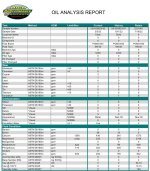A couple months ago, I decided to get the catch can contents sent in for oil analysis. I was periodically collecting it and putting it into a sample container, however, I noticed that when the weather got really cold the catch can contents went from looking like straight oil to looking like I had a blown head gasket. The first sample was collected @ 2400 miles into the OCI and looked like oil from the drain plug. The second sample was collected 3000 miles later, or 5400 miles into the OCI.
I will make a few observations, but I am going to ping our good friend, @High Performance Lubricants, to really tell us what we learned from this method of collection, because even Dave was surprised at what the testing found- it was completely opposite of what he expected! I don't have the actual UOA tests to share, as Dave thought there could be some misinterpretation of the results and he will explain what's going on.
Quick background: '19 F-150 EB, ~60.5k miles now. JLT catch can on passenger PCV circuit. The tube runs uphill from the valve cover, and the catch can is located above the engine as well, so we can be sure there is no liquid flow- all collection was in vapor form when it entered the can. One of the things that was curious to me, and maybe makes sense to the board formulators - while many of the metallic oil additives were present in the catch can sample, they were in fractional measurements compared to the virgin oil. However, the calcium levels doubled in the "wet" winter sample, and calcium is hygroscopic (attracts water) so this makes sense. What it actually means is TBD, but in my small thinking it makes sense why we see the need for shortened OCIs in freezing temps- in addition to fuel dilution, more of the detergent package is carried out of the oil because it's absorbed in the water vapor in the crankcase.
I think there's also some actual evidence of cleaning, as the catch can samples showed existence of some additives that are not in HPL's oils but are definitely in the Ravenol DXG I used previously! I think this is along the same line as when @OVERKILL C&P'd his oil filter after exclusively using Mobil 1 EP. TBD as well
I'll stop there, but I'm super excited for Dave to share! Some people love catch cans, some people think they're as useful as mammary glands on a bull... but I think this will be interesting for both camps!
I will make a few observations, but I am going to ping our good friend, @High Performance Lubricants, to really tell us what we learned from this method of collection, because even Dave was surprised at what the testing found- it was completely opposite of what he expected! I don't have the actual UOA tests to share, as Dave thought there could be some misinterpretation of the results and he will explain what's going on.
Quick background: '19 F-150 EB, ~60.5k miles now. JLT catch can on passenger PCV circuit. The tube runs uphill from the valve cover, and the catch can is located above the engine as well, so we can be sure there is no liquid flow- all collection was in vapor form when it entered the can. One of the things that was curious to me, and maybe makes sense to the board formulators - while many of the metallic oil additives were present in the catch can sample, they were in fractional measurements compared to the virgin oil. However, the calcium levels doubled in the "wet" winter sample, and calcium is hygroscopic (attracts water) so this makes sense. What it actually means is TBD, but in my small thinking it makes sense why we see the need for shortened OCIs in freezing temps- in addition to fuel dilution, more of the detergent package is carried out of the oil because it's absorbed in the water vapor in the crankcase.
I think there's also some actual evidence of cleaning, as the catch can samples showed existence of some additives that are not in HPL's oils but are definitely in the Ravenol DXG I used previously! I think this is along the same line as when @OVERKILL C&P'd his oil filter after exclusively using Mobil 1 EP. TBD as well
I'll stop there, but I'm super excited for Dave to share! Some people love catch cans, some people think they're as useful as mammary glands on a bull... but I think this will be interesting for both camps!

